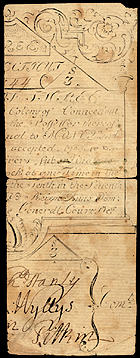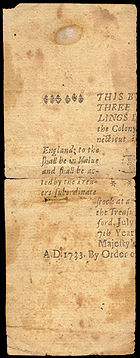An emission of £30,000 in legal tender bills of credit. The notes were authorized by acts of February, May and October, 1733 to be partly used to exchange for notes from the issue of August 1732, and partly to be used to finance additional mortgage loans (as had been done in the August 1732 issue); finaly the remainder of the isse was to be used to pay for public expenses. The issue was redemable by May 1st of 1741. The front of the notes were engraved by Nathaniel Mors of Boston on two copper plates, while the backs were typeset by Timothy Green, who printed the issue. Notes printed after the October act were distinguished with the word Octo engraved on the face plate of each denomination. The larger plate (10s-£5) was used again in 1735 for another issue, this time adding the date 1735 on the face of each denomination and completely resetting the typed backs. The front of each note displays the main text in a framed border with an image of an animal below. The animal differed on each denomination and was used as an aid by the illiterate. On the bottom left is the seal of the colony with three grape vines with the motto "QUI TRANSTULIT SUSTTINET" (What is transplanted survives). Denominations in this issue were: 2s, 2s6d, 3s, 5s, 10s, 20s, 40s and £5.
 rev
rev
Size: 138 x 51mm (a complete note would be about 100mm wide).
Comments: This is one half of a 3s note. The central text ends with the word Octo added, showing this note is part of the third part of the emission after the act of October. The space to the right of the triangle below the main text is blank, showing this is not one of the later redated 1735 notes (also the typeset back is like the 1733 variety rather than the 1735 issue). The back half of a seated squirrel is seen to the right of the triangle. The full text on the obverse would have read as follows:
THREEI have not seen the full text for the reverse of this denomination, so I cannot reconstruct it as was done for the front (the front is based on a full example of the 1735 issued as pictured in Newman's fourth edition). Extrapolating the reverse from a 5s note the text of the reverse would read as follows:
CONNECTICUT
3s [serial number] 3s
THIS BILL OF THREE
Shillings Due from the Colony of Connecticut
in New England; tp the Possessor thereof,
Shall be in Value equal to MONEY and
shall be accordingly accepted by the
Treasurer and Receivers Subordinate to
him and for any Stock at any Time in the
Treasury Hartford, July ther Tenth in the Seventh
Year of his MAJESTYS Teign Anno Dom:
1733 By Order of the General Court: Octo
THIS BILL OF / THREE SHILLINGS DUE FROM / the Colony of Con- / necticut in New / England; to the Possessor thereof / shall be in Value equal to Money / and shall be ac- cordingly accep- /ted by the Trea- surer & Receiv- / ers subordinate to him, and for any / stock at any time in / the Treasury. Hart- / ford, July the 10th, In the / 7th Year of His / Majesty's Reign / A.D. 1733. By Order of the Geberal Court, October.Lines 6-10 on the back are divided with a typset design in the center.